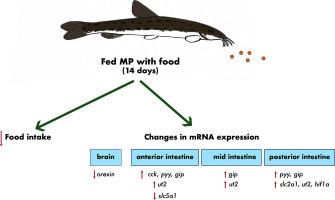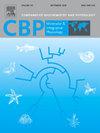Microplastics affect food intake and the expression of appetite regulators and nutrient transporters in pond loach (Misgurnus anguillicaudatus)
IF 2.2
3区 生物学
Q4 BIOCHEMISTRY & MOLECULAR BIOLOGY
Comparative Biochemistry and Physiology A-Molecular & Integrative Physiology
Pub Date : 2025-09-25
DOI:10.1016/j.cbpa.2025.111935
引用次数: 0
Abstract
Microplastics (MPs) are emerging pollutants in freshwater ecosystems, posing risks to aquatic organisms. This study examines the effects of dietary MP exposure on food intake, appetite regulation, and nutrient transporter expression in pond loach (Misgurnus anguillicaudatus), a sediment-feeding facultative air breathing freshwater fish. Fish were exposed to small (250–300 μm), medium (425–500 μm), and large (710–850 μm) polyethylene microspheres for two weeks. Food intake was significantly reduced in fish fed small and medium MPs, but not large MPs, suggesting size-dependent ingestion effects. In the brain, MP (425–500 μm) exposure suppressed orexin expression, a key appetite-stimulating neuropeptide, while other central appetite regulators remained unchanged. In the anterior intestine, anorexigenic peptides such as cholecystokinin (cck) and peptide YY (pyy) were upregulated, alongside glucose-dependent insulinotropic polypeptide (gip), indicating enhanced satiety signaling. Sodium-dependent glucose transporter 1 (slc5a1) expression was downregulated, suggesting impaired glucose absorption. MPs induced upregulation of gip and urea transporter 2 (slc14a2) in the mid intestine, and pyy, gip, glucose transporter 1 (slc2a1), urea transporter 2 and hypoxia-inducible factor 1α (hif1a) in the posterior intestine. These results show that MP exposure disrupts feeding, alters endocrine signaling, and affects nutrient absorption in pond loach, highlighting the physiological sensitivity of sediment-feeding fish to MP contamination and the ecological risks posed by plastic pollution to aquatic species and ecosystems.

微塑料影响塘泥鳅的摄食及食欲调节因子和营养转运蛋白的表达。
微塑料是淡水生态系统中的新兴污染物,对水生生物构成威胁。本研究考察了塘泥鳅(Misgurnus anguillicaudatus)(一种以沉积物为食的兼性空气呼吸淡水鱼)饮食中MP暴露对食物摄入、食欲调节和营养转运蛋白表达的影响。将鱼暴露在小(250-300 μm)、中(425-500 μm)和大(710-850 μm)聚乙烯微球中两周。喂食小、中型MPs的鱼的食物摄取量显著减少,但喂食大MPs的鱼的食物摄取量没有显著减少,这表明摄取量依赖于大小。在大脑中,MP(425-500 μm)暴露抑制了食欲素(一种关键的食欲刺激神经肽)的表达,而其他中枢食欲调节因子保持不变。在前肠中,厌氧肽如胆囊收缩素(cck)和YY肽(pyy)与葡萄糖依赖的促胰岛素多肽(gip)一起上调,表明饱腹感信号增强。钠依赖性葡萄糖转运蛋白1 (slc5a1)表达下调,提示葡萄糖吸收受损。MPs诱导中肠gip和尿素转运蛋白2 (slc14a2)上调,后肠pyy、gip、葡萄糖转运蛋白1 (slc2a1)、尿素转运蛋白2和缺氧诱导因子1α (hif1a)上调。这些结果表明,MP暴露会扰乱池塘泥鳅的摄食,改变内分泌信号,影响营养吸收,突出了沉积物摄食鱼类对MP污染的生理敏感性以及塑料污染对水生物种和生态系统造成的生态风险。
本文章由计算机程序翻译,如有差异,请以英文原文为准。
求助全文
约1分钟内获得全文
求助全文
来源期刊
CiteScore
5.00
自引率
4.30%
发文量
155
审稿时长
3 months
期刊介绍:
Part A: Molecular & Integrative Physiology of Comparative Biochemistry and Physiology. This journal covers molecular, cellular, integrative, and ecological physiology. Topics include bioenergetics, circulation, development, excretion, ion regulation, endocrinology, neurobiology, nutrition, respiration, and thermal biology. Study on regulatory mechanisms at any level of organization such as signal transduction and cellular interaction and control of behavior are also published.

 求助内容:
求助内容: 应助结果提醒方式:
应助结果提醒方式:


